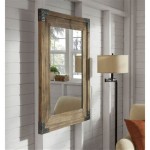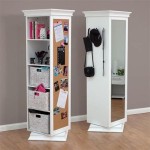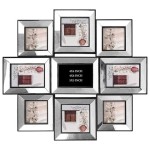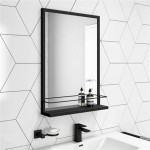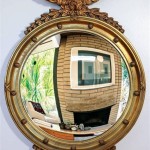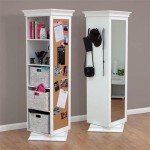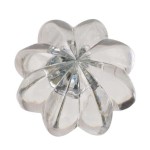How Do Over-the-Door Mirrors Work?
Over-the-door mirrors offer a convenient and space-saving solution for adding a full-length mirror to any room. Their seemingly simple design belies a clever mechanism that allows them to hang securely and safely on a standard door. Understanding how these mirrors work involves examining their construction, the physics involved, and the various hanging mechanisms employed.
The core component of any over-the-door mirror is the mirror itself. Typically made of glass coated with a reflective material like silver or aluminum, these mirrors vary in thickness and quality. Thicker mirrors offer greater durability and less distortion, while thinner mirrors are lighter and often more affordable. The mirror is typically encased in a frame, which provides structural support and protects the edges of the glass. Frames can be constructed from a variety of materials, including wood, metal, or plastic, and contribute significantly to the overall aesthetic of the mirror.
The hanging mechanism is the crucial element that differentiates over-the-door mirrors from traditional wall-mounted mirrors. Several different types of hanging mechanisms exist, each designed to accommodate various door styles and thicknesses. One common type uses hooks that hang over the top edge of the door. These hooks are often padded to prevent scratching or damaging the door's surface. The weight of the mirror itself helps to secure the hooks in place. Another variation involves adjustable brackets that grip the top of the door, offering a more secure and customizable fit. These brackets can often be adjusted to accommodate different door thicknesses, ensuring a snug fit.
The physics involved in the stability of an over-the-door mirror is relatively straightforward. Gravity plays a key role, pulling the mirror downwards and creating tension against the hanging mechanism. This downward force is countered by the upward force exerted by the door frame on the hooks or brackets. The stability of the mirror depends on the balance between these forces. A well-designed hanging mechanism distributes the weight of the mirror evenly across the top of the door, minimizing stress on any single point and preventing the mirror from tilting or shifting.
Over-the-door mirrors are often designed with added features to enhance their functionality and user experience. Some models include adjustable tilt mechanisms, allowing users to customize the angle of the mirror for optimal viewing. This feature is particularly useful for individuals of varying heights. Other models incorporate storage solutions, such as shelves or hooks, on the back of the mirror or within the frame. These additions provide convenient storage for small items like jewelry, accessories, or grooming products, maximizing space utilization.
Installation of an over-the-door mirrors is typically straightforward and requires no specialized tools. Most models simply require placing the hooks or brackets over the top of the door, ensuring a snug fit. Some models with adjustable brackets may require slight adjustments to ensure optimal stability. It's important to check the manufacturer's instructions for specific installation guidance and to ensure the door is strong enough to support the weight of the mirror.
Maintaining an over-the-door mirror is relatively simple. Regular cleaning of the mirror surface with a suitable glass cleaner helps to maintain its reflectivity and prevent streaks. The frame can be cleaned with a damp cloth, depending on the material. Periodically checking the hanging mechanism for wear and tear is also recommended to ensure continued safe and secure use. Tightening any loose screws or adjusting the brackets can help to maintain stability and prevent damage to the door.
The versatility of over-the-door mirrors makes them suitable for a range of environments. They are frequently found in bedrooms, bathrooms, and dressing rooms, providing a convenient full-length reflection for checking outfits or applying makeup. Their space-saving design makes them particularly well-suited for smaller spaces where a traditional standing or wall-mounted mirror might be impractical. The variety of styles and finishes available ensures that an over-the-door mirror can be found to complement any décor.
Safety considerations are important when using an over-the-door mirror. Ensuring the mirror is securely attached to the door is paramount to prevent it from falling and causing injury or damage. Choosing a mirror with a sturdy frame and a well-designed hanging mechanism is crucial. Regularly inspecting the hanging mechanism for signs of wear or damage is also essential. Avoiding excessive force or pressure on the mirror, such as leaning heavily against it, can also help to prevent accidents.
The continued popularity of over-the-door mirrors testifies to their practicality and effectiveness. Their simple yet ingenious design offers a convenient and space-saving solution for incorporating a full-length mirror into any room. Understanding the mechanics and physics involved in their operation allows users to appreciate their functionality and ensure safe and effective use.

Over The Door Hanging Mirrors A Comprehensive Guide

Everything About Over The Door Mirror

Saving Space And Gaining Style With Over The Door Mirrors

Over The Door Hanging Mirrors A Comprehensive Guide

Over The Door Hanging Mirrors A Comprehensive Guide

Over The Door Mirror Guide

3 Ways To Hang A Door Mirror Wikihow

Over The Door Mirror Guide

Over The Door Hanging Mirrors A Comprehensive Guide

Saving Space And Gaining Style With Over The Door Mirrors

